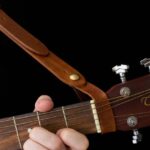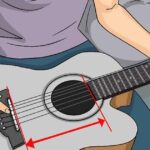Fret buzz on an acoustic guitar is a problem where the strings, when played, vibrate against a fret other than the one you’re pressing down. This causes a buzzing or rattling sound. It can result from issues like low string action or uneven frets. Fixing fret buzz may involve adjusting the guitar’s setup, including the string height and neck relief, or addressing fret irregularities
Fret buzz can dampen your musical joy, but fear not! Learning how to fix fret buzz on your acoustic guitar is easier than you might think. In this guide, we’ll unravel the secrets to achieving those clear, crisp notes without the bothersome buzz, so you can enjoy playing to your heart’s content.
Before diving into the solutions, it’s essential to understand what causes fret buzz. Factors like incorrect string height, uneven frets, or changes in humidity can contribute to this issue. We’ll walk you through a step-by-step process, from assessing the problem to making adjustments, or recommending when to seek professional help. With these practical tips, you’ll be well on your way to eliminating that pesky fret buzz and enhancing your guitar-playing experience.
Understanding Fret Buzz

Fret buzz occurs when a string vibrates against a fret wire, creating an undesirable buzzing or rattling sound. Several factors can contribute to fret buzz, including:
1. String Height (Action)
The height of your guitar strings, commonly referred to as action, plays a crucial role in causing or preventing fret buzz. If the action is too low, the strings can come into contact with the frets, resulting in buzz. Conversely, if the action is too high, it can make your guitar harder to play. When deciding whether to Learn Acoustic Or Electric Guitar First, achieving the right balance is key.
2. Uneven Frets
Sometimes, frets may not be perfectly level, leading to inconsistencies in string contact and causing buzzing. This issue can be due to wear and tear or poor craftsmanship. It’s essential to check for uneven frets and address them accordingly.
3. Neck Relief
The curvature of the guitar neck, known as neck relief, can affect the string-to-fret distance. Too much or too little relief can lead to fret buzz. Adjusting the neck relief is a common solution to this problem.
4. Nut or Saddle Issues
Issues with the nut (the small piece at the headstock end that holds the strings) or the saddle (the piece at the bridge end) can cause strings to sit too low, resulting in fret buzz. Proper adjustments to the nut and saddle can resolve this issue.
5. String Gauge
The gauge of your guitar strings (the thickness of the strings) can also contribute to fret buzz. Heavier gauges tend to vibrate less and are less prone to buzz, while lighter gauges may buzz more if the action is too low.
Now that we’ve covered the common causes of fret buzz, let’s delve into the steps you can take to diagnose and fix the problem.
Diagnosing Fret Buzz
Before you attempt to fix fret buzz, it’s important to diagnose the issue correctly. Here’s a step-by-step process to help you identify the source of the buzzing:
Check String Height (Action)
- Use a feeler gauge or a ruler to measure the string height at the 12th fret. It should be around 2.0mm to 2.5mm on the low E string (6th string) and slightly less on the high E string (1st string).
- Compare your measurements to the recommended action for your guitar. You can find this information in your guitar’s manual or online.
Inspect the Frets
- Carefully examine the frets to check if they are level. Look for visible wear, dents, or irregularities in the frets.
- Use a straight edge (a long, straight object like a ruler) to see if the frets are level. Lay it across several frets and check for any gaps or rocking.
Check Neck Relief
- With your guitar in playing position, look down the neck from the headstock towards the body. Observe the curvature of the neck.
- If the neck appears too flat or bowed, you may need to adjust the neck relief. If you’re unsure, consult your guitar’s manual for recommended relief specifications.
Inspect the Nut and Saddle
- Examine the nut and saddle for any visible issues, like uneven grooves, worn-out slots, or improper string spacing.
- Ensure that the strings sit properly in their slots, neither too high nor too low. The strings should have adequate clearance over the first fret when played open.
Consider String Gauge
- If you’re using a lighter gauge of strings and experiencing fret buzz, consider switching to a slightly heavier gauge, which may reduce buzzing issues.
By following these diagnostic steps, you can pinpoint the specific cause of the fret buzz on your acoustic guitar. Once you’ve identified the issue, it’s time to take corrective action.
Fixing Fret Buzz
The methods to fix fret buzz vary depending on the root cause. Let’s explore the solutions for each of the common causes we discussed earlier.
Adjusting String Height (Action)
1. Raising the Action
If the action is too low and causes fret buzz, you can raise the string height by adjusting the saddle height. Here’s how to do it:
- Loosen the strings to relieve tension on the saddle.
- Remove the saddle from its slot in the bridge.
- Carefully sand the bottom of the saddle to reduce its height.
- Reinstall the saddle and tune the strings back to pitch.
- Check for fret buzz and repeat the process if needed.
2. Lowering the Action
To lower the action, follow these steps:
- Loosen the strings to relieve tension on the saddle.
- Remove the saddle from its slot in the bridge.
- Add a shim, which can be a small piece of cardboard or a specialized saddle shim, under the saddle.
- Reinstall the saddle and tune the strings back to pitch.
- Check for fret buzz and repeat the process if needed.
Leveling and Dressing Frets
If you’ve determined that uneven frets are the cause of your fret buzz, it’s time to level and dress the frets. This process involves making the frets even and smooth to ensure proper string contact. Here’s how to do it:
Tools You’ll Need:
- Fret leveling file or sanding beam
- Fret crowning file
- Sandpaper (various grits)
- Fret rocker (a tool to check for uneven frets)
- Masking tape
Steps:
- Use the fret rocker to identify which frets are uneven.
- Mask off the fretboard with masking tape to protect it from accidental scratches.
- Use the fret leveling file or sanding beam to level the uneven frets. Ensure that you maintain an even, flat surface across all frets.
- Once leveled, use the fret crowning file to reshape the frets into a rounded profile.
- Use progressively finer grits of sandpaper to polish the frets until they’re smooth and shiny.
- Remove the masking tape and restring your guitar.
Adjusting Neck Relief
If you suspect that neck relief is causing fret buzz, you can adjust it as follows:
Tools You’ll Need:
- Truss rod wrench (provided with your guitar or available at music stores)
Steps:
- Ensure your guitar is tuned to its standard pitch.
- Locate the truss rod adjustment nut. It’s typically accessible either at the headstock or inside the soundhole.
- To reduce neck relief (back bow), turn the truss rod clockwise. To increase relief (upward bow), turn it counterclockwise.
- Make small, quarter-turn adjustments, allowing time for the neck to settle.
- Check for fret buzz at various points on the fretboard after each adjustment.
Nut and Saddle Adjustments
If the nut or saddle is causing your fret buzz, you can make the necessary adjustments as follows:
1. Nut Adjustment
- To raise the nut, add a small shim under it.
- To lower the nut, file the bottom until it’s at the desired height.
- Ensure the strings sit properly in their slots without being too high or too low.
2. Saddle Adjustment
- As previously explained, raising or lowering the saddle height can address string height issues.
- Make sure the saddle is correctly seated in its slot, and the strings pass over it without any obstructions.
Changing String Gauge
If you suspect that the string gauge is contributing to the fret buzz, you can switch to a heavier gauge of strings. This will reduce the likelihood of buzz, especially if the action is relatively low. Be sure to adjust the truss rod and saddle height if needed to accommodate the change in string tension.
Common Mistakes to Avoid
While fixing fret buzz on an acoustic guitar, there are some common mistakes that you should be aware of and avoid to prevent further damage or complications:
1. Over Adjusting the Truss Rod
Over Adjusting the truss rod can lead to a warped or broken neck. Make small, gradual adjustments, and be patient, as it may take some time for the neck to settle.
2. Filing the Nut or Saddle Excessively
If you need to lower the nut or saddle, avoid excessive filing, as this can lead to irreversible damage. It’s better to make small adjustments and check the results regularly.
3. Using the Wrong Tools
Using incorrect tools or poor-quality tools can damage your guitar. Invest in proper luthier tools or take your guitar to a professional if you’re unsure.
4. Rushing the Process
Take your time when diagnosing and fixing fret buzz. Rushing through adjustments can lead to errors and worsen the problem.
When to Seek Professional Help
While many cases of fret buzz can be resolved by following the steps outlined above, some issues may require the expertise of a professional luthier or guitar technician. Here are some situations in which you should consider seeking professional help:
- If you’re uncomfortable making adjustments to your guitar’s truss rod or frets.
- When the guitar has multiple issues that need simultaneous attention.
- If your guitar is an expensive or vintage instrument that you want to protect from any potential damage.
- When the fret buzz persists despite multiple DIY attempts.
A professional can not only diagnose the issue accurately but also ensure that your guitar is set up to its best possible playability.
Preventing Fret Buzz
Preventing fret buzz is often easier than fixing it after it occurs. Here are some tips to help you prevent fret buzz on your acoustic guitar:
1. Regular Maintenance
Keep your guitar in good condition by maintaining it regularly. Clean the fretboard, change strings when they become worn, and inspect the instrument for any signs of wear or damage.
2. Correct String Height
Set the string height (action) to the manufacturer’s recommendations or your personal preference. Use a straight edge to check the action periodically and make adjustments as needed.
3. Optimal String Gauge
Choose a string gauge that suits your playing style and the guitar’s setup. Heavier strings tend to be more resilient to fret buzz.
4. Proper Storage
Store your guitar in a controlled environment with stable temperature and humidity levels. Extreme environmental changes can affect the neck and cause fret buzz.
5. Professional Setup
Consider getting your guitar professionally set up by a qualified luthier or technician. They can ensure that your guitar is in the best possible condition for playing.
Guide to Fixing Fret Buzz on Acoustic Guitar
| Aspect | Description |
| Common Causes of Fret Buzz | – String Height (Action) – Uneven Frets – Neck Relief – Nut or Saddle Issues – String Gauge |
| Diagnosing Fret Buzz | – Checking String Height – Inspecting Frets – Evaluating Neck Relief – Examining Nut and Saddle – Considering String Gauge |
| Fixing Fret Buzz | – Adjusting String Height (Action) – Leveling and Dressing Frets – Adjusting Neck Relief – Nut and Saddle Adjustments – Changing String Gauge |
| Common Mistakes to Avoid | – Over Adjusting the Truss Rod – Excessive Nut or Saddle Filing – Using the Wrong Tools – Rushing the Process |
| When to Seek Professional Help | – Uncomfortable with Adjustments – Multiple Guitar Issues – Expensive or Vintage Instrument – Persistent Fret Buzz |
| Preventing Fret Buzz | – Regular Maintenance – Correct String Height – Optimal String Gauge – Proper Storage – Professional Setup |
| FAQs | – Causes of Fret Buzz – DIY Fret Buzz Fixes – When to Seek Professional Repair |
FAQs
What causes fret buzz on my acoustic guitar?
Fret buzz can happen due to low string action, uneven frets, or changes in weather affecting your guitar’s setup.
Can I fix fret buzz myself?
Yes, you can often fix it by adjusting your guitar’s setup, but it might require professional help if the issue is severe.
How do I know if my guitar needs professional repair?
If adjusting the setup doesn’t eliminate the fret buzz, or if you’re uncomfortable making adjustments, it’s wise to consult a guitar technician for expert assistance.
Conclusion
Resolving fret buzz on your acoustic guitar is a manageable challenge that enhances your playing experience. By understanding the causes and following the step-by-step solutions provided in this guide, you can restore the clear, buzzing-free sound you desire. Remember, issues like string action, fret height, and environmental factors play pivotal roles in creating fret buzz.
Additionally, don’t hesitate to seek professional assistance if needed, as skilled guitar technicians can help address complex problems. The key is patience and practice, as achieving the perfect setup may take some time. So, don’t be disheartened if it doesn’t happen immediately. With dedication and the knowledge you’ve gained, you’ll soon be enjoying your acoustic guitar to its fullest potential, free from the annoyance of fret buzz. Happy strumming!




